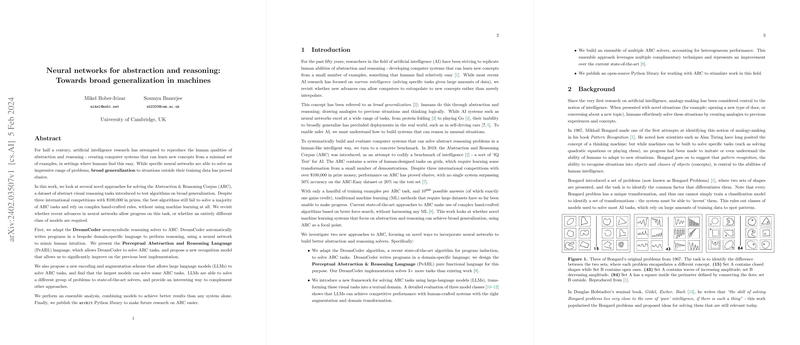Neural Networks for Abstraction and Reasoning: Towards Broad Generalization in Machines
Introduction to ARC Challenges
The field of AI has long pursued the goal of fostering broad generalization in machines—enabling them to learn new concepts from a minimal set of examples in ways akin to human cognition. The Abstraction and Reasoning Corpus (ARC), designed to measure such capabilities, presents abstract visual reasoning tasks requiring broad generalization beyond the training data. Despite significant interest and efforts, including international competitions, solving ARC tasks remains a formidable challenge, with state-of-the-art algorithms either failing to tackle the majority of ARC tasks or resorting to complex hand-crafted rules without leveraging ML.
Novel Approaches Examined
This paper investigates two novel approaches to tackling ARC tasks through recent advancements in neural networks. Firstly, the adaptation of the DreamCoder algorithm demonstrates significant strides, with the introduction of the Perceptual Abstraction & Reasoning Language (PeARL) enhancing DreamCoder's capabilities. Secondly, a novel methodology enabling LLMs to address ARC tasks reveals that the most advanced models can solve certain problems, indicating a complementary pathway to traditional solvers.
Ensemble Analysis and arckit Library
Beyond individual model performance, this paper proposes an ensemble approach, combining various models to surpass the capabilities of any single system. This methodology not only highlights the heterogeneity of the ARC challenges but also underpins the creation of the arckit Python library, designed to facilitate future research in this vein.
Reflections on Performance
Performance analysis sheds light on the significant challenge ARC poses, with even the most advanced ML models solving only a fraction of the tasks. Despite this, the paper's findings underscore the effectiveness of DreamCoder and its enhancements, achieving a 16.5% accuracy on ARC-Easy and 4.5% on ARC-Hard tasks, marking a notable improvement over previous implementations. The investigation into LLMs further contributes to this discourse, showcasing their potential despite the inherent limitations of current models.
Findings on Model Complementarity
A particularly compelling aspect of this research is the discovery of the complementary nature of different models in tackling ARC tasks. The low overlap in solved tasks between models like DreamCoder and GPT-4 suggests that an ensemble approach, leveraging the diverse strengths of various algorithms, could dramatically improve overall performance.
Future Directions
The ongoing challenge ARC presents invites further exploration, with potential avenues including the extension of DreamCoder to incorporate more complex DSL features, the application of LLMs through advanced prompting techniques, and the exploration of Large Vision Models for visual reasoning. Additionally, the impending release of ARC2 promises to heighten the benchmark for broad generalization in AI, encouraging continued innovation in this field.
Conclusion
In conclusion, this paper not only propels our understanding of ML models' capabilities and limitations in abstract reasoning and generalization but also provides a robust framework for future research. By embracing the complexity of ARC tasks and exploring novel methodologies and ensemble approaches, this research moves us closer to achieving the goal of broad generalization in machines—a cornerstone in the journey toward advanced artificial intelligence.
